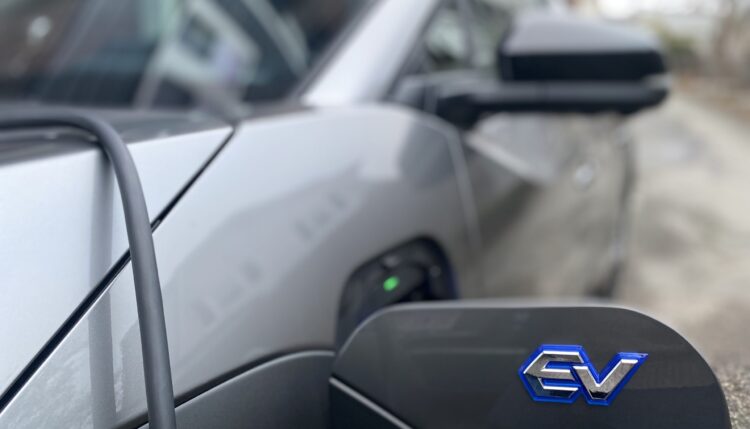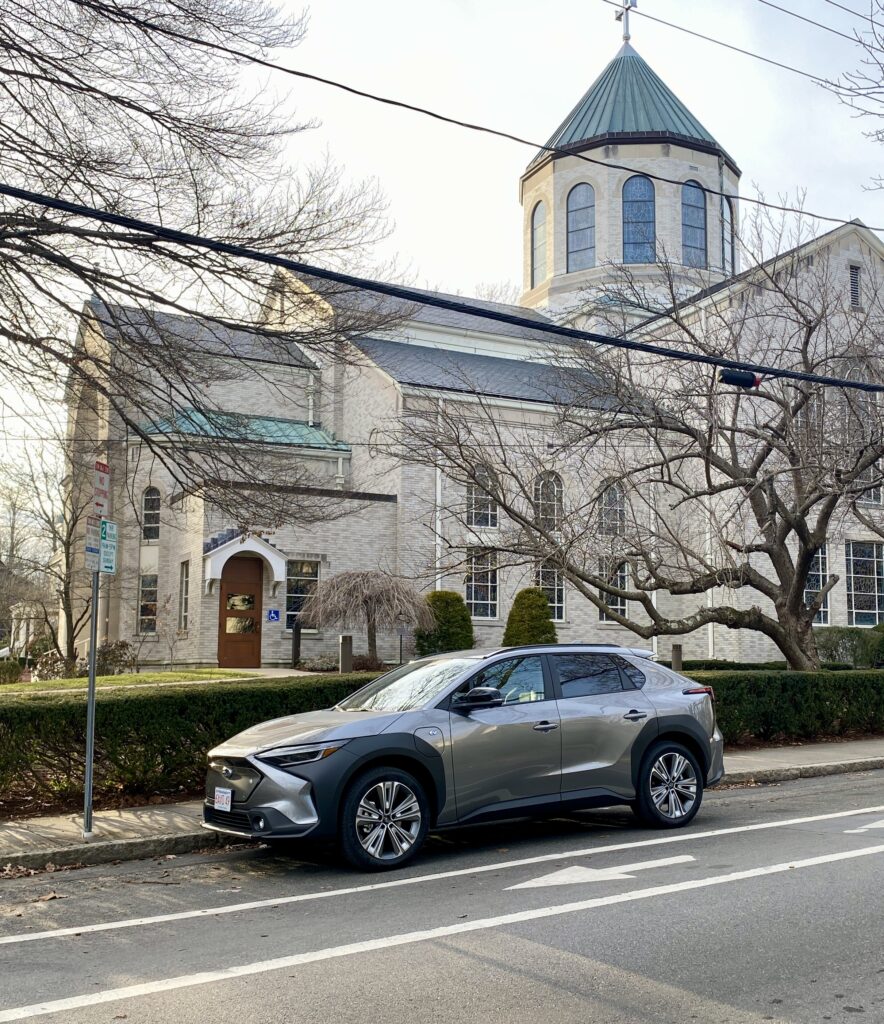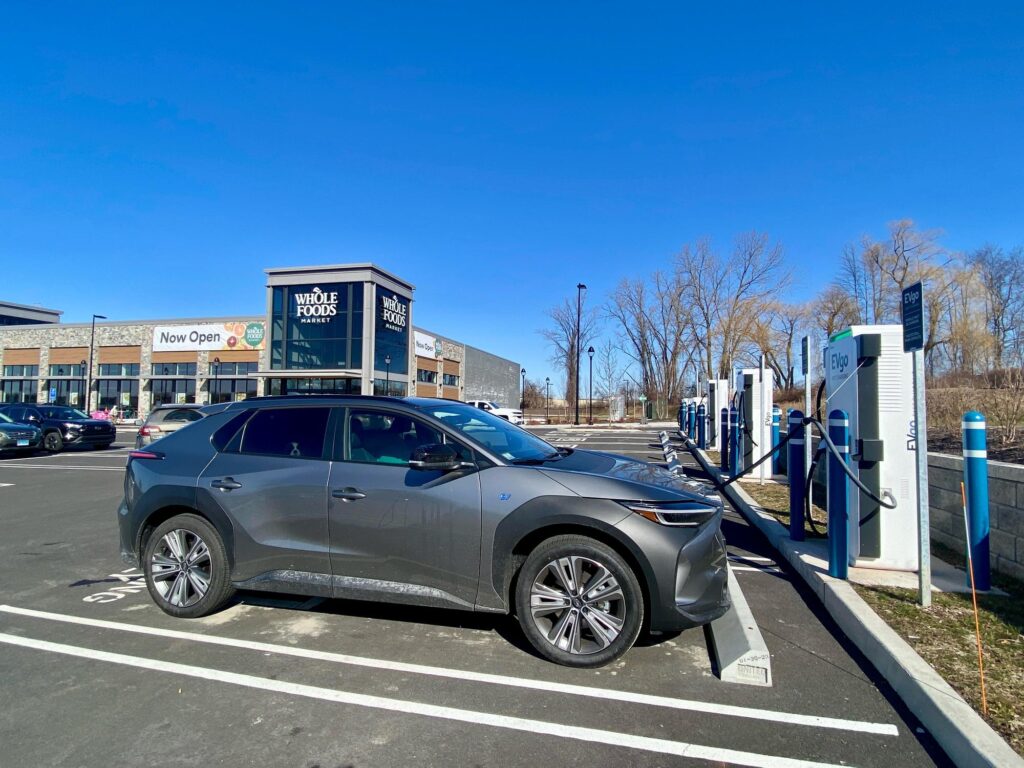We installed a mini-split heat pump in our home in 2021 — not a whole-home system, just one wall-mounted unit in the living area, because that was all we could…

Real-world range, charging, and fun: Our EV experience
Our house has been a power plant since 2017; now it’s also a gas station of sorts.
In January, we signed a three-year lease on our first electric vehicle, a 2023 Subaru Solterra. We’ve never leased a car before, but felt it made a lot of sense in this case because a) EV technology is evolving so quickly that we might want a newer, more advanced model three years from now, and b) due to a loophole for corporate fleets or something, dealers can claim (and pass on to consumers) the $7,500 federal EV tax credit on a lease even if the car doesn’t qualify for a purchase credit (because the battery isn’t assembled in the US, for example).
We opted for the Solterra, in particular, despite some well-known downsides (which I’ll get to), because:
- We loved the size and look of it. It’s not too big for the city — plus, anything larger starts to feel like a manslaughtermobile — yet it has enough cargo space to go camping and stuff. (Other all-wheel drive EVs we looked at, including the Polestar 2 and Volvo C40 Recharge, had significantly less cargo space than what we’d grown used to in our little Subaru Impreza.)
- We really wanted all-wheel drive. We’ve been extremely grateful for the Impreza’s sure-footedness on snowy roads in winters past. That eliminated some other EVs without an AWD option, like the Hyundai Kona EV or Bolt EUV (ok, the Bolt also had a tiny trunk).
- The only other options remotely in our price range were the Volkswagen iD.4 and the Hyundai Ioniq 5 — that latter of which, frankly, does much better when it comes to the “E” part of EV (and is currently offering pretty spectacular lease deals). The Ioniq 5 has a longer range than the Solterra, it charges much more quickly on road trips at a DC fast charger, and it even comes with vehicle-to-grid (V2G) capability — allowing you to draw current from its charged battery to power your refrigerator during a blackout, for example. However, at the time, the iD.4 was hard to find, and the price on the Ioniq 5 was a couple hundred dollars a month more than the Solterra. The Ioniq 5 also has a really wide turning radius, and if we’re being honest, well, I bang a lot of ueys! That was a surprisingly big turnoff for me.
Three months and roughly 3,000 miles in, here are some of the pros and cons of EV ownership we’ve encountered, including real-world range, charging times, and other EV experiences.
Pro: Our EV is the nicest car we’ve ever owned, by a long shot.
Now, to be fair, I’ll add this caveat: Two new cars ago we had a 2004 Kia Rio — a base model with no air conditioning, crank windows, manual door locks, and no power steering(!). Our most recent newbie was the 2014 Subaru Impreza, which we love, but still has like, a real physical key and a CD player and other artifacts of the not so distant past. So, this isn’t a comparison with like a 2022 BMW or something.
But still, the Solterra isn’t just the nicest car we’ve ever owned, it’s also the best car I’ve ever driven. It is whisper quiet inside. The driving experience is so responsive, nimble, and powerful — even in ECO mode (the least aggressive setting, intended to preserve battery life), the acceleration is astoundingly quick. I don’t speed on local roads, but I do get a fair amount of delight zipping from 0-30mph in literally one second after sitting next to a gas-gargling Big Boy pickup truck at a stop light. We can reliably zip a left turn when the light turns green before the oncoming traffic even knows what happened. And I love being able to warm up the car a few minutes before leaving the house — while it’s still plugged in, so it doesn’t drain the battery.

Pro: It feels really good not to be spewing carbon.
We have rooftop solar panels and source the rest of our electricity through the Green Energy Consumers Alliance, so our car literally runs on sunbeams and other renewable sources. (Isn’t that freakin’ rad? We’re in the future!)
This is not everyone’s primary concern, I know (to my great dismay), but it feels extremely good not to be burning fossil fuels or spewing exhaust into pedestrians’ faces. It is a huge weight off my shoulders.
If you want to think about carbon footprint — and I beg you to do so — a gallon of gasoline produces about 20 pounds of carbon dioxide after combustion. We’ll shift about 10,000 miles of driving per year from our 30-miles-per-gallon Impreza to the 0 mpg Solterra — eliminating more than 3 TONS of carbon dioxide per year. (And that’s coming from a fairly efficient and under-driven gas car. Someone driving 15,000 miles per year in a 17 mpg SUV (such as the patently ridiculous Chevy Suburban) produces almost NINE tons of carbon dioxide annually — 17,650 pounds of CO2.)
Also note: Yes, if you just plug your EV into your house and you don’t have solar power or make a point to select 100% renewable energy from your utility, then your EV will not run solely on sunbeams. There is still a lot of natural gas in the Massachusetts power grid. However, fossil fuels are, by state law, supplying an ever lower and lower portion of our electricity; as of 2021, nearly half (48%) of the state’s electricity came from renewable sources, and that will continue to increase, by law, every year.

Con: EV range can be limiting — especially in very cold weather.
I have yet to experience true range anxiety in our EV, but that’s partly because I’ve tried not to put ourselves in that kind of situation. We still have our old gas Impreza, and we used that on a long trip to Vermont in February, when temperatures were very cold and charging infrastructure was spotty. I’m not sure we would have felt comfortable getting the Solterra as our one and only vehicle just yet.
The Solterra is rated at 222 miles of range, which is pretty middling as far as newer EVs go, even given the all-wheel drive. The AWD Ioniq 5, for example, gets 260 miles on a full charge. (I learned that the Ioniq doesn’t use its AWD all the time, only when accelerating or when the car thinks it’s needed — which I don’t really like the sound of? — but that probably improves the range.) The rear-wheel drive models top 300 miles on a full charge; and Tesla’s AWD long-range Model 3 gets more like 330 miles, but we are Musk-averse in our house.
Still, you can go a lot of places on 220 miles of range, and charging infrastructure is pretty reliable in eastern Massachusetts.
That said, while I take it slow on local roads, I tend to drive 70-75 mph on long highway trips. And as EV drivers everywhere will tell you, and I can confirm: real-world range suffers once you go above 65 mph.
Hills also make a noticeable difference — good and bad, meaning you’ll lose range going uphill but gain it back going down. We got slightly better range coming home from my in-laws in the Hudson Valley, and I’m pretty sure it’s because we’re driving from 900 feet above sea level down to, well, zero — sea level.
And while our projected mileage is typically pretty accurate to within a few miles — and occasionally even better than predicted — our range really suffered in the cold. That 222 miles was really more like 160 miles in 25-degree weather. That’s not just a Solterra issue, either: Most EVs lose about 25% of their range in sub-freezing temperatures.
And range matters… at least, if you drive often, or drive long distances. In colder weather, we can’t quite make it all the way to my in-laws in New York on a full charge, which is a bummer. Granted, it’s a 4-hour drive, so we always stopped for a lunch, gas, or pee break anyway. But now we truly must stop, and it’s never going to be just a 5-minute fill-up. But that’s a trip we make maybe four or five times a year; 95 percent of the time, we’re just driving 5 to 50 miles at a time around the Boston area, and range really doesn’t matter that much.
One other issue here is if you drive a lot and OFTEN. Gina works part time, and I work mostly from home, so it’s rare that we need to drive a ton of miles on back to back days. But if you’re routinely putting 60-100 miles per day on the car, you’ll need to be more diligent about charging every night.
Pro: There are so few moving parts.
We definitely considered getting a plug-in hybrid (PHEV) instead of a full EV. That way, most of our driving around Boston would be fully electric, but we could still just top up at a gas station on long road trips. Best of both worlds, right?
The main problem was that plug-in hybrids are also quite expensive, yet don’t qualify for as many tax credits. I love the new plug-in Toyota Prius — the highest-end trim even has a solar panel on the roof (!), so you can get up to 30-some-odd miles of free, clean-powered driving just leaving the car in a parking lot — but it tops $40,000, and there’s no all-wheel-drive option. The plug-in Rav-4 Prime has AWD, but it’s close to $50,000.
And the other thing? A fully electric vehicle literally has HUNDREDS fewer moving parts than a traditional gas-powered or hybrid vehicle. Isn’t that crazy? There’s barely a transmission — the Solterra uses a single gear. This means there are like a thousand fewer things that can break or that need to be maintained.
Con: The Solterra’s real-world fast-charging is slower than many other EVs.
Ok, I’m going to try and sum up the world of EV charging for you real quickly. It’s not that complicated, but this was all brand new to me a few months ago, and might be new to you, too — we’re in the future, after all!
There are three types of EV charging:
- Level 1 is the slowest, most basic form of EV charging, and this is simply charging from an ordinary 120 volt household outlet, like the one you’d plug your refrigerator or holiday lights into. You can expect to get just over 1 kilowatt per hour this way. This is how we charge at home, and we can replenish about 20% of the car’s battery (about 42 miles) per 12 hours.
- Level 2 charging requires a 240 volt outlet — the kind you’d use for an electric dryer — and it gives you about 6.5 kilowatts per hour, about five or six times faster than Level 1. You can get one of these installed at home by an electrician, and it can easily take a car from 0% to 100% overnight, charging the battery at about 8–10% per hour. These are often the public chargers you’ll see at restaurants, hotels, libraries, and even Mass Audubon trailheads.
- Level 3 refers to DC fast charging (DCFC). These chargers are designed to replenish your battery as fast as possible, akin to stopping at a gas station. They vary by network, but most are capable of pumping out 50 to 300 kilowatts per hour. If your car can handle that kind of charge — that’s a big if, as we’ll see in a minute — then you could go from 20% to 80% in a matter of 15 minutes.
Now, about that IF: The Solterra is theoretically capable of pulling up to 150 kwh off a fast charger, but no one has seen it do that in real life. (The dominant theory is that Toyota, which designed the electric components for Subaru, intentionally slows the DC charging to protect the longevity of the battery.) When we fast-charge, we generally pull about 25–65 kwh, even if the charger is rated for much higher output. On our road trips to New York, it takes about 30-45 minutes to gain an extra 100 miles or so. It’s not a big deal, but it’s pretty slow compared to other EVs. Only the Chevy Bolt and some older EVs like the Nissan Leaf seem to be similarly slow.
Remember how I said the Ioniq 5 is better at being an EV? Hyundai knows what it’s doing in the electric realm, and its cars routinely pull 100–150 kwh or more at DC fast chargers. I’ve seen them pull in, charge up by 40% or 50%, and leave, while our Solterra patiently inches up by 10%, seeming to suck the power through a coffee straw. And Teslas have access to Tesla Superchargers, which are well located and screaming fast. (Most EVs will begin making Tesla-compatible charging ports in 2025.)
Still, this is really only an issue for us a few times a year; most of the time we don’t need a fast charger, because we’re always leaving the house with a full “tank.”
When we take any kind of road trip, I generally check an app or site like PlugShare to locate a couple of charging stations along the route. It’s good to have a backup in mind, in case there’s a broken charger or a long line when you get there (we haven’t experienced this yet, knock on wood, but friends traveling around the holidays did).

Pro: Electricity is cheaper than gas (and sometimes free).
Even in winter, when utility companies just about double their electric rates (because of home heating demand for natural gas), it has been much cheaper to “fill our tank” with electrons rather than gasoline.
We generally get about 3-5 miles per kilowatt hour (my very best is 5.5 mi/kwh; fast highway driving —e.g., 70+ mph — is least efficient, at around 3 mi/kwh). Electricity prices in the Boston area are quite high compared to the national average, at 29 cents per kwh in February. But even at that rate, driving 300 miles at an average of 4 mi/kwh would cost us about $22; driving the same distance on 10 gallons of gas (at 30 mpg) would cost us about $34. Over the course of a year, that’s a savings of about $500 — and that’s based on a higher winter electric rate and a relatively low gas price.
What’s more, that doesn’t factor in the free solar power we get from our rooftop panels, or free charging at our employers.
However, if you rely on DC fast charging stations, you’ll pay a premium for the convenience — most seem to charge around 35 to 65 cents per kwh.
Pro: One-pedal driving is awesome.
I think one of the more underrated features of most electric cars is the feel of regenerative braking and one-pedal driving.
As you might know, hybrids and EVs use regenerative braking to recharge the battery as the car slows down, converting some of the kinetic energy from that resistance into battery power. Most EVs allow you to choose how aggressive you want this feature to be. And in a purely electric vehicle, you can even use “one-pedal driving,” where pushing down on the gas accelerates, and letting up on the gas engages the resistance of regenerative braking; if no one jumps in front of you or cuts you off, you can pretty much complete an entire errand without using your actual brakes (saving lots of wear on your brake pads), and it can extend your range slightly, too.
But what I love most about this feature is how it mimics the downshift of a manual transmission. I used to love driving a standard (stick shift), and one of the best parts was being able to gradually “brake” simply by downshifting — as you approached an exit or intersection, for example. It’s been a long time since we had a manual transmission, what with my creaky old knee and penchant for drinking coffee in the car, so the more active driving and grabby resistance of regenerative braking has been an absolute delight.
Con: There’s no established charging etiquette.
Our friend who encountered crowded charging stations over the holidays raised another compelling complaint: There’s no established etiquette yet around charging. They’re typically parking spots, not pull-through affairs like the gas station, so how do you wait in line? (Our friend had someone swoop in ahead of him even though he was waiting beside an occupied charger for half an hour.)
Early on, there weren’t a whole lot of EV drivers, so it didn’t really matter. But people are buying EVs way faster than we’re building out the fast-charging infrastructure to support them, and that’s leading to a bit more competition for chargers — as well as frustration and flared tempers.
Most EV drivers on Reddit seem to agree that you should only charge to 80% at a DC fast charger, especially if there are people waiting. For one thing, most cars slow down their charging speed to protect the battery as it gets near a full charge. So you might go from 20% to 80% in 20 minutes, but take a full hour to get that last 20%, which is super annoying to someone waiting for the charger to free up. (Plus, it’s generally accepted that DC fast-charging right up to 100% is pretty rough on the battery.)
The problem is, not everyone knows that yet, or reads EV subreddits. Some kind of standard charging etiquette will emerge organically, I’m sure — but it’s going to take patience and time, as George Harrison would say, to do it right.

Pros: There are nice tax credits and rebates.
Finally, there’s a lot to be said for free money. Electric vehicles still, on the whole, cost more than their gas counterparts; it was pretty frustrating knowing that we could have simply replaced our beloved Impreza hatchback with a brand-new gas version for about half the price of the new Solterra.
However, federal and state incentives can bring the price down significantly. What’s more, dealerships are increasingly able to award these rebates at the point of sale, meaning you can sometimes use the rebate as a down payment, or at least don’t have to wait until you file next year’s taxes to get the money.
In Massachusetts, pretty much any new all-electric vehicle will qualify for a $3,500 rebate through the MOR-EV program. Some used EVs qualify for the rebate as well, if the sale price is under $40,000 and the buyer earns less than $75,000 a year (or $150,000 combined for a married couple).
Federal tax credits are even juicier — up to $7,500, on top of state rebates — but also more complicated. That’s because only some models are eligible, due to price limits and rules about where cars and their batteries are made (the intent being to encourage domestic manufacturing, which seems to be working). A few EVs and plug-in hybrids get partial credit, with rebates up to $3,750. Consumer Reports maintains the best and most updated clearinghouse of qualifying electric vehicles that I’ve found.
But here’s the thing: Most EV models under $80,000 are eligible for the $7,500 tax credit if they’re leased, due to some kind of loophole. The credit technically goes to the dealership, but they have been passing this on to customers, and that brings down both your monthly payment and the total payoff amount should you decide to buy the car outright when your lease is up.
I didn’t go into this expecting to buy out our Solterra in three years, and it seems a good bet that technology will have improved even more by then. But I’ll be honest, I really love this car so far — so maybe we will end up buying out the lease after all, we’ll see!




